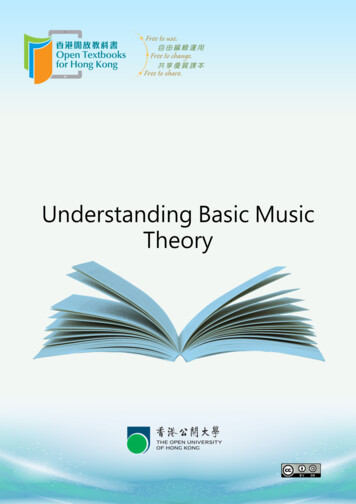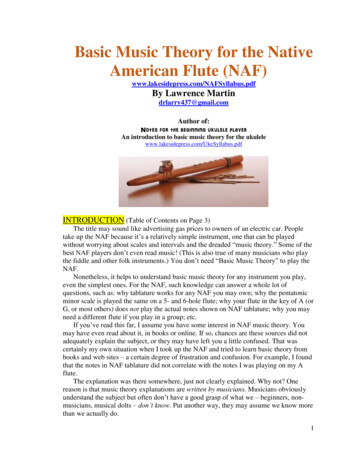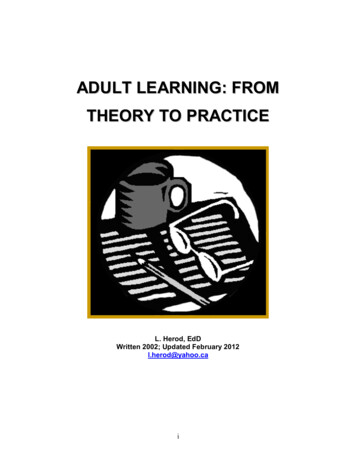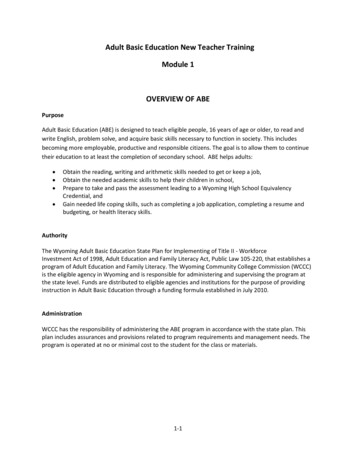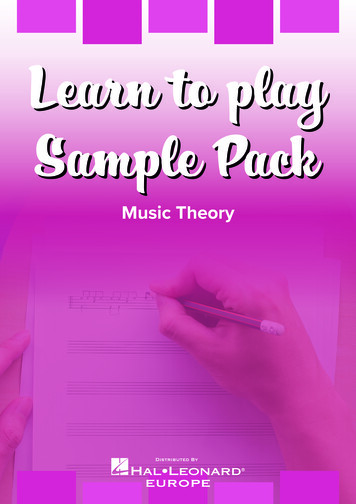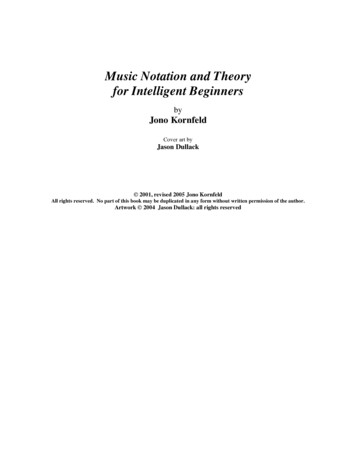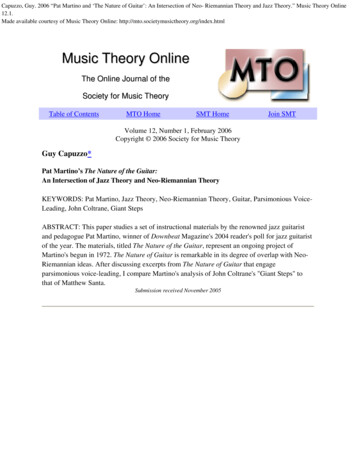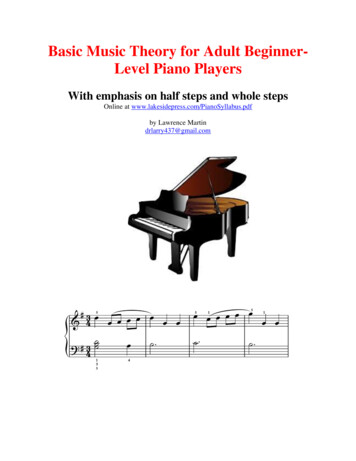
Transcription
Basic Music Theory for Adult BeginnerLevel Piano PlayersWith emphasis on half steps and whole stepsOnline at www.lakesidepress.com/PianoSyllabus.pdfby Lawrence Martindrlarry437@gmail.com
Basic Music Theory for Adult Beginner-Level Piano PlayersWith emphasis on half steps and whole stepsOnline atwww.lakesidepress.com/PianoSyllabus.pdfby Lawrence Martindrlarry437@gmail.comText explanations copyright 2019-2021 by Lawrence MartinFigures in the Syllabus are from the Internet, either in the public domain or withpermission to use.Cover: First four measures of Minuet in G, from the Clavier Book of AnnaMagdalena Bach. For centuries this famous piece was assumed to be by JohannSebastian Bach, but authorship is now attributed to Christian Petzold (1677-1733),a Bach contemporary. For more on this piece, see Appendix C.AcknowledgmentsI would like to thank the following people for their meticulous review of thissyllabus: Ruth Martin, Glenn Perry, Rosamond van der Linde, and Preston Davis.They have helped catch typos, mistakes, and confusing passages in earlier drafts.My goal is to make sure everything herein is clear to the beginner; if not, please letme know and I will make any necessary changes.ii
Table of Contents (Ctrl left click on any item to go directly to that section)Introduction . ivHow To Use This Syllabus . vSection 1: Half Steps and Whole Steps. 1Section 2: Music Scales – Definition of Major and Minor Scales . 6Section 3: Music Scales – Relation of Major to Minor . 14Section 4: More on Scales and Modes . 18Section 5: Music Intervals . 23Section 6: Tritones, Compound Intervals, and Interval Inversions . 29Section 7: Three-Note Chords: Major, Minor & Diminished . 37Section 8: Three-Note Chord Inversions . 45Section 9: Four-Note Chords: Sevenths . 49Section 10: More on Seventh Chords – 3-Note Sevenths and Inversions . 52Section 11: Chords in the Bass Clef . 55Section 12: Chords in Lead Sheets and Song Sheets . 60Section 13: Chord Progressions . 65Section 14. Music Keys . 72Appendix A: Circle of Fifths . 79Appendix B. Music Modes Explained . 86Appendix C: Q & A on Petzold’s Minuet in G . 98Appendix D: Q & A on Clementi Sonatina Op. 36, No. 1 . 100Appendix E: Skill Levels of Piano Players – What Level Are You? . 104Appendix F: Simple Time and Compound Time .108Appendix G: Chord Voicing .123Additional Recommended Resources 138Answers to Multiple Choice Questions .144iii
Basic Music Theory for Adult Beginner-Level Piano PlayersWith emphasis on half steps and whole stepsIntroductionMusic theory is a huge subject, one whose study can become quite complex. Basic Music Theoryfor Adult Beginner-Level Piano Players covers the subject selectively. The emphasis, as stated inthe subtitle, is on the one aspect I believe MOST USEFUL for adults who wish to review somebasic music theory: half steps and whole steps. (Some sources use the term semitones for wholesteps and half tones for half steps; in this syllabus I will stick with half steps and whole steps.)This syllabus does not cover some other important aspects of basic music theory, such as notedurations, rhythm and time signatures. After the appendices you will find a list of AdditionalRecommended Resources related to basic music theory, for those who wish to delve further.In studying music theory, I have been surprised and confounded that most written materials onthe subject (books, monographs, websites) tend to under-emphasize the concept of half steps andwhole steps. It’s surprising, because the simple method of counting half and whole steps canenhance understanding of music scales, chords and intervals, as well as “music keys” and“modes.”I am a beginner-level player, not a trained pianist. This might be considered the ultimate‘chutzpah’, to write a music theory syllabus when not a true musician. However, it’s not as crazyas it sounds. First, I am a profession nal writer, with 20 books to date, plus two other syllabuseson music theory, one for the ukulele and one for the Native American flute. Both are free andavailable d, as a beginner-level piano player and student of music theory, I recognize the confusionoften generated by experts who write on the subject. I think the confusion arises because expertsoften don’t realize what beginners don’t know, and they don’t go to proper lengths to explain thesubject. A good example of this is in the area of music modes. (See Appendix B for myexplanation of modes.) Going to “proper lengths” in explaining music theory to beginner-levelplayers should include repetition, questions with answers, and audio examples, and I haveincorporated these elements into each section of the syllabus.In summary, this syllabus is for a specific audience, adults who consider themselves at thebeginner to near-intermediate level and seek a better understanding of music theory, specificallyscales, chords, intervals, keys and modes. If you’re not sure what level you’re at, check outAppendix E. Of course, players of any skill level are welcome to peruse this syllabus; just keepin mind that it’s basic theory, stuff an advanced player probably knows backwards and forwards.iv
How To Use This SyllabusThis syllabus is for the beginner-level adult piano player with an interest in music theory. All thefigures in this Syllabus are from free internet sources. In particular, I highly recommendwww.basicmusictheory.com, for its excellent keyboard and clef figures of all the commonchords and scales. The keyboard figures from this website have the design of letters in yellowboxes and numbers in red circles, such as the one below.Appendix E gives several sources that explain the various piano-playing levels. I emphasize“beginner-level” because this Syllabus is really basic information, albeit in a format that may benew to the reader.You can start from the beginning and read through the Sections in order, or skip around. Youmay already know much of what’s in here, but not seen it actually explained, in writing, orviewed any of the videos linked throughout the Syllabus. My goal is to explain every topicclearly, using piano and clef diagrams and, in various places, video from the internet.This figure, found throughout the Syllabus, indicates Youtube links that demonstratesome scale, interval or musical passage, or give a concise video lecture. If you have agood understanding of basic theory but want to hear musical examples, or hear brieflectures on a particular topic, skip around to this symbol and click on the links.Another approach, instead of reading the sections in order or viewing all the videos, is to take themultiple-choice quizzes at the end of each Section. If the questions seem simple, the answersreadily apparent, you probably don’t need that Section.Whatever approach you use, it’s good that you’re interested. That interest should make you abetter player.Lawrence Martindrlarry437@gmail.comMay, 2021The Villages, FLv
Section 1: Half Steps and Whole StepsHere is the middle section of the piano keyboard, with its series of white and black keys.The piano is tuned based on sound frequencies of notes that have evolved over the centuries, inthe Western tradition (some Eastern music has different notes and won’t be discussed here).Below is the C chromatic scale, which includes every key between one C and the next higher C.That’s 13 keys in all: 8 white keys (including both Cs), and five black keys.Click link below for demonstration of chromatic scalehttps://www.youtube.com/watch?v sr2rXc9Qu4A1
Each of these notes has a specific sound frequency when struck, and this frequency is universalacross all standard pianos. Middle C (the fourth C key from left on a standard 88-key pianokeyboard, sometimes referred to as C4) is 261.6 hz, which means that when you strike middle C,a sound wave is generated that causes the air to vibrate back and forth 261.6 times a second.When you strike A above middle C, the sound wave generated is 440 hz.The difference between any two adjacent keys, including all the black and white keys, is a halfstep. The difference between two keys when there is another key in between is a whole step.Thus, for example, C to C# is a half step, C# to D is a half step, E to F is a half step, B to C is ahalf step, etc. C to D is a whole step, as are E to F#, G to A, and A# to C, etc.If you look at the actual frequencies of each piano key, starting from middle C to the next higherC, you’ll see that notes a half step apart have about half the frequency difference as do notes awhole step apart. (The note frequencies are equencies.html.)Thus: C to D (whole step) difference 42.1 hz, but from E to F (half step) difference 19.6 hz E to F# (whole step) 40.4 hz, but (again) from E to F (half step) 19.6 hz A# to C (whole step) 57.1 hz, but from B to C (half step) 29.4 hz.So the concept of half steps and whole steps is rooted in simple sound wave physics. Half stepshave about half the frequency span as do whole steps. Playing these notes on the keyboard willquickly demonstrate the aural difference between half steps and whole steps.Now let’s look at the C major scale, starting from one C to the next C. It has no black keys, sothe scale is simply: C-D-E-F-G-A-B-C.2
Demo of the C major scale:https://www.youtube.com/watch?v QDWKzG5oaogNote that all the adjacent white keys of the C major scale are a whole step apart except for E to Fand B to C, which are a half step apart. This is visually apparent. In the C major scale, the whitekeys a whole step apart have a black key between them. The white keys that are a half step apart(E-F and B-C) do not have a black key between them.Now try to visualize the keyboard in your mind, and while doing so write down the sequence ofwhole and half steps for the C major scale. Visualize the keyboard in your mindas you write the C major scale onpaper.You should be able to write down the following -wholeB--halfCWriting down this C major scale – simply by visualizing the keyboard without actually lookingat it – will help lay the foundation for the following sections on scales, chords, intervals, musicalkeys, and modes.3
4
TEST YOUR UNDERSTANDING OF THIS SECTION. Choose the single best answer.1. Middle C on a standard 88-key keyboard is:a. C1b. C2c. C3d. C42. Based on the pattern of whole and half steps for a major scale, the number of half stepsfrom one C to the next higher C is:a. oneb. twoc. threed. four3. Based on the pattern of whole and half steps for a major scale, the number of whole stepsfrom one C to the next higher C is:a. threeb. fourc. fived. six4. In the C chromatic scale, the number of half steps from C to the next higher C is:a. eightb. tenc. elevend. twelve5. A half step in the C major scale occurs between:a. C and C#b. B and Cc. E and F#d. D and E5
Section 2: Music Scales – Definition of Major and Minor ScalesThe C major scale, shown above, has the following series of whole (w) steps and half (h) steps.w-w-h-w-w-w-hThis sequence of whole and half steps is the pattern for all major scales. Conversely, any seriesof 8 notes with this whole step-half step sequence is a major scale. It doesn’t matter if you starton D, E, F, G#, Bb or any other key, black or white. Proceed with this exact sequence of wholeand half steps and you will be playing the major scale for that starting note.Go to the keyboard, or if one is notimmediately available, bring up asimulated keyboard from theinternet. Here is one I recommendthat does not require anydownloading (see screen shot):https://virtualpiano.net/Start on D and play the above sequence of whole and half steps; you will be playing the D majorscale. Any black keys? Let’s see.6
Demo of the D major scale:https://www.youtube.com/watch?v kHX3sUohaCUStarting on D, the first step is a whole step, so we go from D to EThe next step is a whole step so we can’t go from E to F, since that would only be a half step;instead, we have to go from E to F#.The next step is a half step so it’s F# to GThe next step is a whole step so it’s G to AThe next step
often don’t realize what beginners don’t know, and they don’t go to proper lengths to explain the subject. A good example of this is in the area of music modes. (See Appendix B for my explanation of modes.) Going to “proper lengths” in explaining music theory to beginner-level

